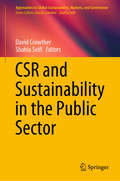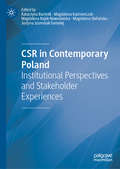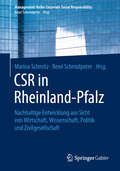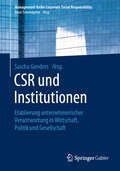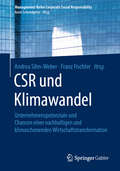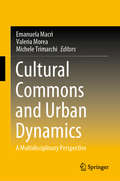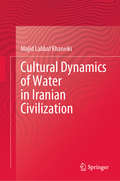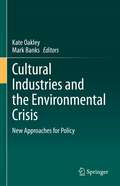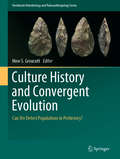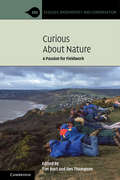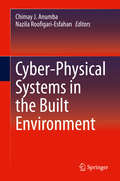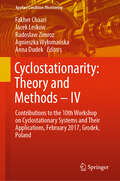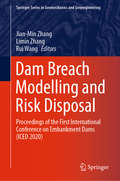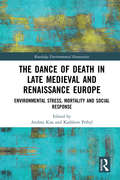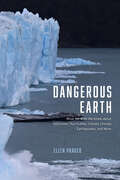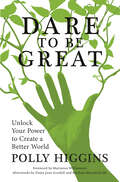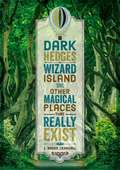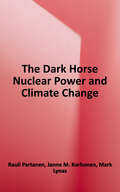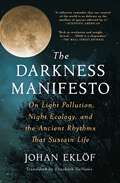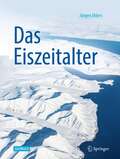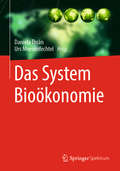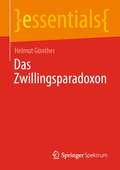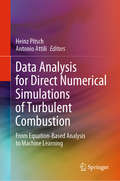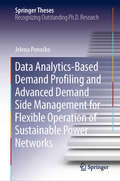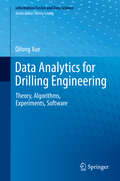- Table View
- List View
CSR and Sustainability in the Public Sector (Approaches to Global Sustainability, Markets, and Governance)
by David Crowther Shahla SeifiThis book focuses on CSR in the public sector, in all its manifestations around the world, in order to consider its application in practice and its connections to sustainable objectives.This book is unique in that all chapters were written by members of the Social Responsibility Research Network. Their ideas have been tested and refined through the feedback given after they were presented at the 16th International Conference.The approach used in this book is based on the tradition of the Social Responsibility Research Network – a worldwide body of scholars that, over its 20-year history, has sought to broaden the discourse and to treat all research as inter-related and business-relevant.The book examines diverse aspects of how CSR and sustainability apply to, and are applied by, a variety of public bodies in a variety of ways. Thus, the authors focus on the priorities of these organisations, in order to consider the extent to which the focus has changed so much that we need to think about new approaches to our understanding of CSR and sustainability and differing effects in practice. The international mix of authors makes this an original contribution, sharing some of the best ideas from around the world
CSR in Contemporary Poland: Institutional Perspectives and Stakeholder Experiences
by Magdalena Stefańska Katarzyna Bachnik Magdalena Kaźmierczak Magdalena Rojek-Nowosielska Justyna Szumniak-SamolejThis book takes an interdisciplinary approach to corporate social responsibility (CSR), examining economic sciences and managements to show the complexity of the contemporary perception and development of CSR in Poland. It considers well-being of workers, the importance of the common good and social innovations in relation to profit. It addresses consumers and organizations, underlining the role and importance of small and medium sized enterprises. This book shows the possibility of improvement management systems by using CSR in business operations. It is valuable reading for academics working in corporate social responsibility, business ethics and in Polish management more generally.
CSR in Rheinland-Pfalz: Nachhaltige Entwicklung aus Sicht von Wirtschaft, Wissenschaft, Politik und Zivilgesellschaft (Management-Reihe Corporate Social Responsibility)
by René Schmidpeter Marina SchmitzDieses Buch liefert Ihnen Managementwissen zur Corporate Social ResponsibilityDieses Buch beschreibt die Entwicklungen im Bundesland Rheinland-Pfalz im Bereich Corporate Social Responsibility (CSR). Die Herausgeber beleuchten dieses Thema aus unterschiedlichen Blickwinkeln. Die Beiträge in diesem Buch arbeiten die Erfahrungen und das Fachwissen von zahlreichen rheinland-pfälzischen CSR-Experten aus folgenden Bereichen auf:WirtschaftWissenschaftZivilgesellschaftPolitikDadurch vermittelt Ihnen dieses Buch einen umfassenden Überblick zur Corporate Social Responsibility und liefert gleichzeitig praxisorientiertes Insiderwissen. Auf diese Weise leistet dieses Buch einen wertvollen Beitrag für die zukünftige Ausrichtung und Weiterentwicklung des Corporate Social Responsibility-Standortes Rheinland-Pfalz. Darüber hinaus erhalten Sie fundiertes Fachwissen und innovative Anregungen – ideal für CSR-Verantwortliche in anderen deutschen Bundesländern.Wie lassen sich Nachhaltigkeit und Wettbewerb vereinen?Das Thema der gesellschaftlichen Verantwortung gewinnt aus Sicht der Herausgeber immer mehr an Bedeutung. Schließlich haben aktuelle Entwicklungen wie die digitale Transformation Auswirkungen auf die zukünftige Wettbewerbsfähigkeit von Unternehmen, zum Beispiel durch eine strategische Etablierung in den Bereichen CSR und unternehmerische Nachhaltigkeit. Um dabei erfolgreich zu sein, vermittelt Ihnen dieses Buch unternehmerisches Managementwissen mit Blick auf Corporate Social Responsibility. Dafür ist das Werk in drei Teilabschnitte untergliedert:Impulse und Fallbespiele aus der WissenschaftStimmen und Fallbeispiele aus der UnternehmenspraxisImpulse und Fallbeispiele von Netzwerkakteuren, Verbänden, Zivilgesellschaft und PolitikErfahren Sie in den gesammelten Fachbeiträgen – verfasst von maßgeblichen Expertinnen und Experten – u. a. mehr über:Nachhaltigkeitsmanagement im MittelstandCSR als Treiber der MitarbeiterbindungKeine Nachhaltigkeit ohne EnergiewendeAttraktives Handwerk – motivierte MitarbeiterViele Handlungsempfehlungen für die PraxisAuf diese Weise beleuchtet dieses Buch das Thema Corporate Social Responsibility nicht nur theoretisch. Bisher unbekannte Brancheneinblicke geben Ihnen Impulse für die Praxis. So sind Sie in der Lage, zukunftsweisende Nachhaltigkeitsstrategien im Rahmen des Sustainable Managements zu konzipieren. Dadurch schließen sich unternehmerische Sozialverantwortung und Wettbewerb nicht aus. Das macht dieses Werk zu einer Empfehlung für Führungspersonen, Mitarbeiter im Change-Management sowie Studierende der Betriebswirtschaftslehre.
CSR und Institutionen: Etablierung unternehmerischer Verantwortung in Wirtschaft, Politik und Gesellschaft (Management-Reihe Corporate Social Responsibility)
by Sascha GendersWerfen Sie einen detaillierten Blick in die Praxis von CSR ausgewählter Institutionen aus den Bereichen Wirtschaft, Politik, Forschung und Zivilgesellschaft Dieses Buch zeigt, welche Rolle Corporate Social Responsibility aus Sicht dieser Akteure spielt. Neben der Beantwortung der Frage nach der eigenen Auseinandersetzung innerhalb der Institution, wird insbesondere verdeutlicht, welche Ansätze zur gesamtgesellschaftlichen Diskussion rund um CSR verfolgt werden. Es wird praxisnah die konzeptionelle, strategische Auseinandersetzung mit Unternehmensverantwortung dargestellt und zugleich vergegenwärtigt, mit welchen konkreten Maßnahmen und Ansatzpunkten - zum Beispiel mit dem Fokus Interessenvertretung oder Dienstleistungen - bei den relevanten Zielgruppen - Unternehmen, Mitgliedern oder interessierter Öffentlichkeit - für die Wahrnehmung von CSR geworben und für dessen Relevanz sensibilisiert wird. Hier gelingt ein erster Versuch den Nexus zwischen der gesellschaftlichen Verantwortung von Unternehmen, den institutionellen Strukturen sowie den globalen Rahmenbedingungen aufzuzeigenIn Anbetracht der zahlreichen Wechselwirkungen zwischen Unternehmen und ihren jeweiligen Standorten, erscheint es nur logisch und konsequent, die Potenziale, Motive, Strategien und Projekte von Unternehmen als „Partner der Gesellschaft“ in Rahmen der Weiterentwicklung gesellschaftlicher Institutionen zu sehen. Denn gesellschaftliche Institutionen können in Sachen Nachhaltigkeit nur so gut sein, wie es die Unternehmen sind. Und umgekehrt gilt, dass Unternehmen nur dann nachhaltige Geschäftsmodelle erfolgreich umsetzen können, wenn die dazu notwendigen institutionellen Rahmenbedingungen vorhanden sind. Die vorliegende Publikation verdeutlicht, dass neue Kooperationen zwischen Wirtschaft, Politik und Zivilgesellschaft zur Förderung Nachhaltigen Unternehmertum die deutsche Institutionenlandschaft konstruktiv verändern wird. Das Buch stellt damit die dringend benötigte Brücke zwischen dem Forschungs- und Handlungsfeldern der gesellschaftlichen, politischen und wirtschaftlichen CSR-Diskussion da.
CSR und Klimawandel: Unternehmenspotenziale und Chancen einer nachhaltigen und klimaschonenden Wirtschaftstransformation (Management-Reihe Corporate Social Responsibility)
by Andrea Sihn-Weber Franz FischlerWie begegnen Unternehmen dem Klimawandel? Dieses Buch zeigt es Ihnen!Dieses Buch gibt Ihnen einen Einblick, wie Sie in der wirtschaftlichen Praxis dem Klimawandel entgegenwirken und erfolgreich mit seinen direkten und indirekten Folgen umgehen. Die Autoren untersuchen die klimawandelinduzierten Risiken und ihre Steuerung aus betriebswirtschaftlicher Sicht. Weiter arbeiten sie heraus, welche Unternehmenspotenziale und Chancen durch eine nachhaltige und klimaschonende Wirtschaftstransformation entstehen können. Auf diese Weise zeigen Ihnen die Herausgeber, wie aus einem der größten Probleme unserer Zeit auch wirtschaftliche Erfolgsmodelle entstehen können. Die einzelnen Fachbeiträge renommierter Autorinnen und Autoren stellen zudem aktuelle Erkenntnisse der Wissenschaft, Pläne der Politik sowie Forderungen von Interessensvertretungen und NGOs vor. Konkrete Best Practice-Beispiele unterschiedlichster Branchen runden den Inhalt ab. Gleichzeitig prüft dieses Werk Klimaziele und Maßnahmen internationaler Initiativen und Entwicklungen, wie beispielsweise das Pariser Klimaabkommen. Dadurch fordert dieses Buch mit Blick auf den Klimawandel Unternehmen im Zuge ihrer ökologischen sowie gesellschaftlichen Verantwortung zum Handeln auf. Innovative Impulse für UnternehmenDieses Buch liefert Ihnen aktuelle Erkenntnisse aus der Wissenschaft zum Klimawandel. Die Autoren erörtern, welche Auswirkungen die Klimakrise auf Wirtschaft und Gesellschaft hat und welche Rolle der Digitalisierung im Kontext von Nachhaltigkeit und Klimaänderung zukommt. Anschließend rücken die folgenden Kapitel unter anderem diese Aspekte in den Mittelpunkt: Internationale, europäische und nationale KlimapolitikDigitalisierung und Klimawandel im Kontext der Sustainable Development GoalsKlimaschonende Veredelung regenerativer RohstoffeVersorgungssicherheit in Zeiten des KlimawandelsIntegration von CSR und Klimaschutz in das Kerngeschäft der Österreichischen Post AGDekarbonisierungsstrategien für Aktieninvestitionen Auf diese Weise liefert dieses Buch Unternehmen zahlreiche Impulse, um im Zuge des Klimawandels innovative Strategien und Anpassungsmöglichkeiten zu entwickeln. So lassen sich bisher unerschlossene wirtschaftliche Potenziale nutzen.
Cultural Commons and Urban Dynamics: A Multidisciplinary Perspective
by Emanuela Macrì Valeria Morea Michele TrimarchiToday, cities are being intensively reshaped by unexpected dynamics. The rise and growth of the digital economy have fundamentally changed the relationship between the urban fabric and its resident community, overcoming the conventional hierarchy based on production priorities. Moreover, contemporary society discovers new labour conditions and ways of satisfying needs and desires by developing new synergies and links. This book examines cultural and urban commons from a multidisciplinary perspective. Economists, architects, urban planners, sociologists, designers, political scientists, and artists explore the impact and implications of cultural commons on urban change. The contributions discuss both cases of successful urban participation and cases of strong social conflict, while also addressing a host of institutional contradictions and dilemmas. The first part of the book examines urban commons in response to institutional constraints from a theoretical point of view. The second and third parts apply the theories to case studies and discuss various practices of sustainable planning and re-appropriation in the urban context. In closing, the fourth part develops a new urban agenda as artists imagine it. This book will appeal to scholars interested in the social, economic and institutional implications of cultural and urban commons, and provide useful insights and tools to help local governments and policymakers manage social, cultural and economic change.
Cultural Dynamics of Water in Iranian Civilization
by Majid Labbaf KhaneikiThis book traces “water” back to the most primitive animistic notions that are still lingering on in the shape of such rituals as qanat marriage or rain-making. Water, in the Iranian philosophy, is used in an attempt to find an explanation for the genesis of the universe, as described in Zoroastrian Akhshij philosophy, according to which water is one of the four fundamental elements of the creation. The concept of time began to germinate in the Iranian mind, when they had to count the passage of time in order to divide their scarce water resources. Water became so omnipresent in Iranian culture that it reached even the most mysterious seclusion of the Sufi monks. In Iran’s local communities, water culture is a thread that runs through different types of production systems. This book goes beyond indigenous water knowledge and traditional irrigation techniques, and conceptualizes water as a pivotal element of Iran’s social identity, cultural dynamics and belief systems, where it examines the role of intermittent droughts in engendering and diffusing intangible cultural elements across the Iranian plateau. This book delves into Iran’s political organizations most of which were ensnared in a water-dependent lifecycle constituting a historical pattern described in this book as “hydraulic collapse” .
Cultural Industries and the Environmental Crisis: New Approaches for Policy
by Kate Oakley Mark BanksThis volume critiques the current model of the creative economy, and considers alternative models that may point to greener, cleaner, more sustainable and socially just cultural and creative industries. Aimed at the nexus of cultural and environmental concerns, the book assesses the ways in which arts and cultural activities can help develop ideas of the ‘good life’ beyond excessive and unsustainable material consumption, and explores the complex interactions between cultural prosperity, place and the quality (and availability) of employment, leisure and the rights to self-expression. Adopting a deliberately wide and inclusive interdisciplinary and international perspective, contributors to this volume showcase current and future ways of ‘doing’ creative economy, ecologically, otherwise and differently. In 11 chapters, the book outlines some of the most relevant arguments from among the growing literature that critically analyzes the current creative economy, with a focus on issues of gentrification, inequality and environment. This volume is timely, as it emerges into a political and economic context that is seeking desperately to ‘reboot’ the economy, re-establish ‘business as usual’ and to do so partly through significant investment and expansion in the creative economy. The book will be suitable for upper level undergraduates and postgraduates studying a wide range of topics, including: cultural and creative industries, media and communications, cultural studies, cultural policy, human geography, environmental humanities and environmental policy, and will be of further interest to arts professionals, creative economy researchers and policymakers. The chapter “Towards a New Paradigm of the Creative City or the Same Devil in Disguise? Culture-led Urban (Re)development and Sustainability” is available open access under a Creative Commons Attribution 4.0 International License via link.springer.com.
Culture History and Convergent Evolution: Can We Detect Populations in Prehistory? (Vertebrate Paleobiology and Paleoanthropology)
by Huw S. GroucuttThis volume brings together diverse contributions from leading archaeologists and paleoanthropologists, covering various spatial and temporal periods to distinguish convergent evolution from cultural transmission in order to see if we can discover ancient human populations. With a focus on lithic technology, the book analyzes ancient materials and cultures to systematically explore the theoretical and physical aspects of culture, convergence, and populations in human evolution and prehistory. The book will be of interest to academics, students and researchers in archaeology, paleoanthropology, genetics, and paleontology. The book begins by addressing early prehistory, discussing the convergent evolution of behaviors and the diverse ecological conditions driving the success of different evolutionary paths. Chapters discuss these topics and technology in the context of the Lower Paleolithic/Earlier Stone age and Middle Paleolithic/Middle Stone Age. The book then moves towards a focus on the prehistory of our species over the last 40,000 years. Topics covered include the human evolutionary and dispersal consequences of the Middle-Upper Paleolithic Transition in Western Eurasia. Readers will also learn about the cultural convergences, and divergences, that occurred during the Terminal Pleistocene and Holocene, such as the budding of human societies in the Americas. The book concludes by integrating these various perspectives and theories, and explores different methods of analysis to link technological developments and cultural convergence.
Curious about Nature: A Passion for Fieldwork (Ecology, Biodiversity and Conservation)
by Des Thompson Tim BurtNotwithstanding the importance of modern technology, fieldwork remains vital, not least through helping to inspire and educate the next generation. Fieldwork has the ingredients of intellectual curiosity, passion, rigour and engagement with the outdoor world - to name just a few. You may be simply noting what you see around you, making detailed records, or carrying out an experiment; all of this and much more amounts to fieldwork. Being curious, you think about the world around you, and through patient observation develop and test ideas. Forty contributors capture the excitement and importance of fieldwork through a wide variety of examples, from urban graffiti to the Great Barrier Reef. Outdoor learning is for life: people have the greatest respect and care for their world when they have first-hand experience of it.
Cyber-Physical Systems in the Built Environment
by Chimay J. Anumba Nazila Roofigari-EsfahanThis book introduces researchers and practitioners to Cyber-Physical Systems (CPS) and its applications in the built environment. It begins with a fundamental introduction to CPS technology and associated concepts.It then presents numerous examples of applications from managing construction projects to smart transportation systems and smart cities. It concludes with a discussion of future directions for CPS deployment in the construction, operation and maintenance of constructed facilities. Featuring internationally recognized experts as contributors, Cyber-Physical Systems in the Built Environment, is an ideal resource for engineers, construction managers, architects, facilities managers, and planners working on a range of building and civil infrastructure projects.
Cyclostationarity: Contributions to the 10th Workshop on Cyclostationary Systems and Their Applications, February 2017, Grodek, Poland (Applied Condition Monitoring #16)
by Fakher Chaari Jacek Leskow Radoslaw Zimroz Agnieszka Wyłomańska Anna DudekThis book gathers contributions presented at the 10th Workshop on Cyclostationary Systems and Their Applications, held in Gródek nad Dunajcem, Poland in February 2017. It includes twelve interesting papers covering current topics related to both cyclostationary and general non stationary processes. Moreover, this book, which covers both theoretical and practical issues, offers a practice-oriented guide to the analysis of data sets with non-stationary behavior and a bridge between basic and applied research on nonstationary processes. It provides students, researchers and professionals with a timely guide on cyclostationary systems, nonstationary processes and relevant engineering applications.
Dam Breach Modelling and Risk Disposal: Proceedings of the First International Conference on Embankment Dams (ICED 2020) (Springer Series in Geomechanics and Geoengineering)
by Jian-Min Zhang Limin Zhang Rui WangThis proceedings book gathers contributions presented at the First International Conference on Embankment Dams (1st ICED, Beijing, 5–7 June 2020), which was the inaugural conference of the International Society of Soil Mechanics and Geotechnical Engineering (ISSMGE) Technical Committee TC210 on Embankment Dams. The contributions address five themes: (1) case histories on the failure of embankment dams and landslide dams; (2) dam failure process modelling; (3) soil mechanics for embankment dams; (4) dam risk assessment and management; and (5) monitoring, early warning and emergency response. These proceedings offer a unique resource that systematically presents recent dam breaching cases, their social impact, associated risk management strategies, and disposal methods for failed dams. It is an excellent reference guide for dam and levee engineers, flood safety officials, and emergency management agencies.
The Dance of Death in Late Medieval and Renaissance Europe: Environmental Stress, Mortality and Social Response (Routledge Environmental Humanities)
by Kathleen Pribyl Andrea KissThis volume investigates environmental and political crises that occurred in Europe during the late Middle Ages and the early Modern Period, and considers their effects on people’s lives. At this time, the fragile human existence was imagined as a ‘Dance of Death’, where anyone, regardless of social status or age, could perish unexpectedly. This book covers events ranging from cooling temperatures and the onset of the Little Ice Age, to the frequent occurrence of epidemic disease, pest infestations, food shortages and famines. Covering the mid-fourteenth to mid-seventeenth centuries, this collection of essays considers a range of countries between Iceland (to the north), Italy (to the south), France (to the west) and the westernmost parts of Russia (to the east). This wide-reaching volume considers how deeply climate variability and changes affected and changed society in the late medieval to early modern period, and asks what factors, other than climate, interfered in the development of environmental stress and socio-economic crises. This book will be of great interest to students and scholars of Environmental and Climate History, Environmental Humanities, Medieval and Early Modern History and Historical Geography, as well as Climate Change and Environmental Sciences.
Dangerous Earth: What We Wish We Knew about Volcanoes, Hurricanes, Climate Change, Earthquakes, and More
by Ellen PragerThe Earth is a beautiful and wondrous planet, but also frustratingly complex and, at times, violent: much of what has made it livable can also cause catastrophe. Volcanic eruptions create land and produce fertile, nutrient-rich soil, but they can also bury forests, fields, and entire towns under ash, mud, lava, and debris. The very forces that create and recycle Earth’s crust also spawn destructive earthquakes and tsunamis. Water and wind bring and spread life, but in hurricanes they can leave devastation in their wake. And while it is the planet’s warmth that enables life to thrive, rapidly increasing temperatures are causing sea levels to rise and weather events to become more extreme. Today, we know more than ever before about the powerful forces that can cause catastrophe, but significant questions remain. Why can’t we better predict some natural disasters? What do scientists know about them already? What do they wish they knew? In Dangerous Earth, marine scientist and science communicator Ellen Prager explores the science of investigating volcanoes, earthquakes, tsunamis, hurricanes, landslides, rip currents, and—maybe the most perilous hazard of all—climate change. Each chapter considers a specific hazard, begins with a game-changing historical event (like the 1980 eruption of Mt. St. Helens or the landfall and impacts of Hurricane Harvey), and highlights what remains unknown about these dynamic phenomena. Along the way, we hear from scientists trying to read Earth’s warning signs, pass its messages along to the rest of us, and prevent catastrophic loss. A sweeping tour of some of the most awesome forces on our planet—many tragic, yet nonetheless awe-inspiring—Dangerous Earth is an illuminating journey through the undiscovered, unresolved, and in some cases unimagined mysteries that continue to frustrate and fascinate the world’s leading scientists: the “wish-we-knews” that ignite both our curiosity and global change.
Dare to Be Great: Unlock Your Power to Create a Better World
by Polly Higgins Marianne Williamson Jane Goodall Michael Mansfield‘I know it may not yet look like it, but we are sowing the seeds of greatness for countless generations to come. That is the Great Work of our times. Yours and mine.’ This is a book unlike any other. It does not tell you what you must do, it does not set out a guide for the 10 definitive steps to becoming great by next Thursday. Dare To Be Great is both a playful, inspirational conversation and a heartfelt, lived call, daring each one of us and our society as a whole to become truly great. Celebrated Earth lawyer Polly Higgins was a luminary in the environmental justice movement as she worked to Stop Ecocide across the globe. She was a beacon for how to live the brave, bold lives that, at our best, we imagine for ourselves. This book shares insights from her own remarkable journey, inspiring us to recognise and step into a greatness within – that is not about grandiosity but something far more exciting: aligning with our unique purpose in service of a better world.
Dark Hedges, Wizard Island, and Other Magical Places That Really Exist
by L Rader CrandallFrom a lost city in the desert to a cave alight with thousands of glowworms, learn about some of the most unusual places on earth and the myths, legends, and history behind each of them!Looking at places like The Skeleton Coast in Namibia, Wizard Island in the United States, and The Fairy Tale Route in Germany, The Dark Hedges and Other Magical Places that Really Exist takes young readers on a journey around the world to real places that sound straight out of fantasy. Featuring both natural and man-made wonders, this travel book combines history and storytelling to explore the far reaches of the earth.
The Dark Horse: Nuclear Power and Climate Change
by Rauli Partanen Janne M. KorhonenClimate scientists consider climate change to be among top threats to humanity’s future. If unchecked, runaway climate change can destroy not just many of our current ecosystems, but wreak havoc in human societies as well. To prevent the worst catastrophe, greenhouse gas emissions from our energy system needs to decline to zero rapidly. We need to replace fossil fuels, which represent roughly 85 % of our energy production, with low-carbon alternatives. To manage this in a low-risk and timely manner, all tools need to be utilized to their maximum potential, including nuclear energy. Nuclear is surrounded by colourful rhetoric, politics, fear and fearmongering, click-bait scandal-headlines and mental images of dangerous radiation and catastrophic accidents. But how much of this is warranted, and how much is based on beliefs, opinions and prejudices? How dangerous is ionizing radiation really? What happened in Chernobyl and Fukushima, and what are the best estimates on their effects on public health and the environment? And can we harness nuclear energy to play a major role in decarbonizing our energy systems rapidly and more affordably? This book takes a serious look how the climate change mitigation is progressing, what needs to be done, and how nuclear has helped in the past, and can help us in the future. Partanen is an award-winning science writer and analyst on climate, environment, energy and society. Korhonen did his PhD in the history of technology, has written about climate and energy for years and is currently researching “Plan B”, an emergency program for climate change mitigation.
The Darkness Manifesto: On Light Pollution, Night Ecology, and the Ancient Rhythms that Sustain Life
by Johan EklöfIn the bestselling tradition of Why We Sleep and The Sixth Extinction, an urgent and insightful look at the hidden impact of light pollution, and a passionate appeal to cherish natural darkness for the sake of the environment, our own well-being, and all life on earth.How much light is too much light? Satellite pictures show our planet as a brightly glowing orb, and in our era of constant illumination, light pollution has become a major issue. The world&’s flora and fauna have evolved to operate in the natural cycle of day and night. But in the last 150 years, we have extended our day—and in doing so have forced out the inhabitants of the night and disrupted the circadian rhythms necessary to sustain all living things, including ourselves. In this persuasive, well-researched book, Swedish conservationist Johan Eklöf urges us to appreciate natural darkness, its creatures, and its unique benefits. Eklöf ponders the beauties of the night sky, traces the errant paths of light-drunk moths and the swift dives of keen-eyed owls, and shows us the bioluminescent creatures of the deepest oceans. As a devoted friend of the night, he writes passionately about the startling damage we inflict on ourselves and our fellow creatures simply by keeping the lights on. The Darkness Manifesto depicts the domino effect of diminishing darkness: insects, dumbfounded by streetlamps, failing to reproduce; birds blinded and bewildered by artificial lights; and bats starving as they wait in vain for food insects that only come out in the dark of night. For humans, light-induced sleep disturbances impact our hormones and weight, and can contribute to mental health problems like chronic stress and depression. The streetlamps, floodlights, and neon signs of cities are altering entire ecosystems, and scientists are only just beginning to understand the long-term effects. The light bulb—long the symbol of progress and development—needs to be turned off. Educational, eye-opening, and ultimately encouraging, The Darkness Manifesto outlines simple steps that we can take to benefit ourselves and the planet. In order to ensure a bright future, we must embrace the darkness.
Das Eiszeitalter
by Juergen EhlersDas Eiszeitalter ist eine Zeit extremer Klimaschwankungen, die bis heute nicht beendet sind. Zeitweilig bedeckten gewaltige Inlandeismassen große Teile der Nordkontinente. Zu anderen Zeiten war die Sahara grün und von Menschen besiedelt, und der Tschadsee war so groß wie die Bundesrepublik Deutschland. Was sich im Eiszeitalter abgespielt hat, kann nur aus Spuren rekonstruiert werden, die im Boden zurückgeblieben sind. Die Eiszeit hat andere Schichten hinterlassen als andere Erdzeitalter. Dieses Buch beschreibt die Prozesse, unter denen sie gebildet worden sind und die Methoden, mit denen man sie untersuchen kann. Die Arbeit des Geowissenschaftlers gleicht der eines Detektivs, der aus Indizien den Ablauf des Geschehens rekonstruieren muss. Und diese Tätigkeit ist genauso spanned wie die eines Detektivs. Von den in diesem Buch vorgestellten Untersuchungsergebnissen werden einige hier zum ersten Mal veröffentlicht. Das Eiszeitalter ist auch der Zeitabschnitt, in dem der Mensch in die Gestaltung der Erde eingreift. Welche Veränderungen das mit sich bringt, kann jeder selbst verfolgen. Alle relevanten Daten sind frei verfügbar; dieses Buch beschreibt, wie man sie erhält. Dr. Jürgen Ehlers arbeitet seit 1978 als Quartärgeologe für das Geologische Landesamt Hamburg, wo er für die Geologische Landesaufnahme zuständig ist. Er hat darüber hinaus Forschungsprojekte im In- und Ausland durchgeführt. Zusammen mit Prof. Philip L. Gibbard, Cambridge, hat er für die International Union for Quaternary Research das Projekt ‚Extent and Chronology of Quaternary Glaciations‘ durchgeführt. Er gilt als einer der hervorragendsten deutschen Kenner der Eiszeitgeologie. Er ist Autor mehrerer Bücher über das Quartär (Enke und Wiley) und die Nordsee (WBG) und auch als Autor von Kriminalgeschichten bekannt geworden.
Das System Bioökonomie
by Daniela Thrän Urs MoesenfechtelDieses Buch ist eine prägnante Gesamtschau auf den Status Quo der Bioökonomie und ihre zukünftigen Entwicklungen – in Deutschland und darüber hinaus. Zahlreiche Praktikerinnen und Praktiker aus Wirtschaft, Wissenschaft, Zivilgesellschaft und Politik zeigen, wie die Bioökonomie den globalen Problemen der Zukunft begegnet. Auf der Basis nachwachsender Rohstoffe und Energien entwickelt die Bioökonomie neue Produkte und Verfahrensweisen und möchte so eine ökologisch und ökonomisch nachhaltigere Zukunft gestalten. Doch kann ihr das gelingen? Wo liegen ihre Möglichkeiten und Grenzen? Welche Rahmenbedingungen beeinflussen sie? Das Buch beantwortet diese Fragen mit einer systemischen Sicht auf die Bioökonomie und ermöglicht so eine schnelle Orientierung in diesem Thema. Das wird durch zahlreiche Grafiken zusätzlich unterstützt. Somit lädt das Buch dazu ein, die Zukunft der Bioökonomie mitzugestalten.
Das Zwillingsparadoxon (essentials)
by Helmut GüntherDie bewegte Uhr geht nach. – Zwei Zwillinge bewegen sich in entgegengesetzter Richtung. Beide beobachten, dass die Uhr des anderen nachgeht. Dann kommen sie wieder zusammen und stellen fest: Jünger ist, wer seine Geschwindigkeit geändert hat. Eine elementare Erklärung dafür folgt aus einer Kette von Ungleichungen auf der Basis der Zeitdilatation. Mit Hilfe der Definition einer absoluten Gleichzeitigkeit finden wir eine weitere, einfache Erklärung. Hierbei ist es wichtig, den definitorischen Charakter der Gleichzeitigkeit zu verstehen. Alternativ zu Einsteins Herleitung formulieren wir einen anschaulichen Zugang zur Speziellen Relativitätstheorie. Dabei können wir über die Gleichzeitigkeit frei verfügen und lösen das Paradoxon sowohl mit der Lorentz-Transformation als auch bei absoluter Gleichzeitigkeit.
Data Analysis for Direct Numerical Simulations of Turbulent Combustion: From Equation-Based Analysis to Machine Learning
by Heinz Pitsch Antonio AttiliThis book presents methodologies for analysing large data sets produced by the direct numerical simulation (DNS) of turbulence and combustion. It describes the development of models that can be used to analyse large eddy simulations, and highlights both the most common techniques and newly emerging ones. The chapters, written by internationally respected experts, invite readers to consider DNS of turbulence and combustion from a formal, data-driven standpoint, rather than one led by experience and intuition. This perspective allows readers to recognise the shortcomings of existing models, with the ultimate goal of quantifying and reducing model-based uncertainty. In addition, recent advances in machine learning and statistical inferences offer new insights on the interpretation of DNS data. The book will especially benefit graduate-level students and researchers in mechanical and aerospace engineering, e.g. those with an interest in general fluid mechanics, applied mathematics, and the environmental and atmospheric sciences.
Data Analytics-Based Demand Profiling and Advanced Demand Side Management for Flexible Operation of Sustainable Power Networks (Springer Theses)
by Jelena PonoćkoThis thesis deals with two important and very timely aspects of the future power system operation - assessment of demand flexibility and advanced demand side management (DSM) facilitating flexible and secure operation of the power network. It provides a clear and comprehensive literature review in these two areas and states precisely the original contributions of the research. The book first demonstrates the benefits of data mining for a reliable assessment of demand flexibility and its composition even with very limited observability of the end-users. It then illustrates the importance of accurate load modelling for efficient application of DSM and considers different criteria in designing DSM programme to achieve several objectives of the network performance simultaneously. Finally, it demonstrates the importance of considering realistic assumptions when planning and estimating the success of DSM programs.The findings presented here have both scientific and practical significance; they gained her BSc and MSc degrees in electrical engineering from the University of Belgrade in 2011 and 2012 respectively. She graduated with her PhD from the University of Manchester. She has presented at several conferences, and has won runner-up prizes in poster presentation at three. She has authored or co-authored more than 40 journal, conference and technical papers.provide a basis for further research, and can be used to guide future applications in industry.
Data Analytics for Drilling Engineering: Theory, Algorithms, Experiments, Software (Information Fusion and Data Science)
by Qilong XueThis book presents the signal processing and data mining challenges encountered in drilling engineering, and describes the methods used to overcome them. In drilling engineering, many signal processing technologies are required to solve practical problems, such as downhole information transmission, spatial attitude of drillstring, drillstring dynamics, seismic activity while drilling, among others. This title attempts to bridge the gap between the signal processing and data mining and oil and gas drilling engineering communities. There is an urgent need to summarize signal processing and data mining issues in drilling engineering so that practitioners in these fields can understand each other in order to enhance oil and gas drilling functions. In summary, this book shows the importance of signal processing and data mining to researchers and professional drilling engineers and open up a new area of application for signal processing and data mining scientists.
